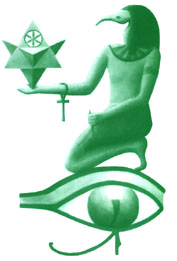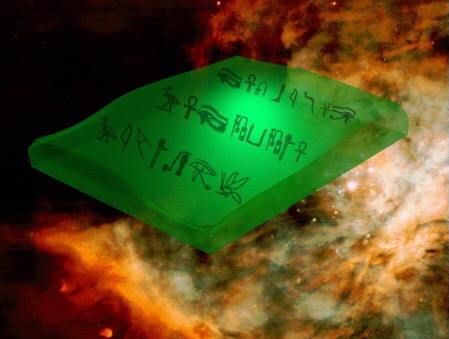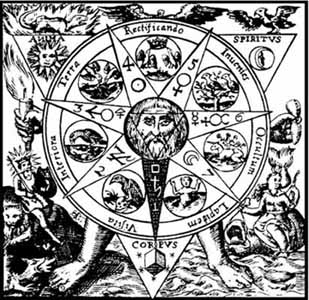
Thoth/Hermes

Thoth/ Tehuti is the teacher of the magical system known as Hermetism of which high magic and Alchemy are thought to be twin branches. The name Trismegistus means thrice greatest Hermes, and is the title given by the Greeks to the Egyptian god Thoth or Tehuti, a lord of wisdom and learning.
At one time the Greeks thought the two gods inseparable. Thoth governed over mystical wisdom, magic, writing and other disciplines and was associated with healing, while Hermes was the personification of universal wisdom and the patron of magic.
The myths go further. Both gods are associated with sacred writings. As scribe for the gods, Thoth was credited with all the sacred books. In various Egyptian writings he is called "twice very great" and "five times very great." Hermes is credited with writing 20,000 books by Iamblichus (ca. 250-300 BC), a Neo-platonic Syrian philosopher, and over 36,000 books by Manetho (ca. 300 BC), an Egyptian priest who wrote the history of Egypt in Greek, perhaps for Ptolemy I.
The combined myths of these gods report that both Thoth and Hermes revealed to humankind the healing arts, magic, writing, astrology, science, and philosophy. Thoth wrote the record of the weighing of the souls in the Judgment Hall and Hermes led the souls of the dead to Hades.
The English occultist in Biographia Antiqua wrote that Hermes "communicated the sum of the Abyss, and divine knowledge to all posterity"
According to legend Hermes Trismegistus is said to have provided the wisdom of light in the ancient mysteries of Egypt. "He carried an emerald, upon which was recorded all of philosophy, and the caduceus, the symbol of mystical illumination.

Notes from the Alchemy Lab:
The Emerald Tablet is an ancient artifact that reveals a profound spiritual technology, which has survived to this day despite centuries of effort to suppress it. Encoded within the tablet's mysterious wording is a powerful formula that works in very specific and comprehensible steps on all levels of reality at once -- the physical, the mental, and the spiritual -- and shows us how to achieve personal transformation and even accelerate the evolution of our species.
The source of alchemy and the Hermetic sciences, the tablet's universal approach made it forbidden knowledge, condemned by patriarchal powers for thousands of years, from the Egyptian priesthood, to the medieval Church, to our modern politicians and religious leaders. To ensure the survival of such "dangerous" principles, which guide people to higher states of consciousness, the ancients concealed their knowledge in a succinct declaration that has become a time capsule of wisdom for future generations.
Molded out of a single piece of green crystal, the Emerald Tablet carries a prophetic message full of hidden meaning. Although its true origin is lost in legends that go back over 10,000 years, the wondrous artifact was translated into Greek by Alexandrian scholars and actually put on display in Egypt in 330 BC.
Around the year 400 AD, it was reportedly buried somewhere on the Giza plateau to protect it from religious zealots who were burning libraries around the world at that time. Many believe the tablet still lies hidden there.
Working only with these early translations, many seekers of truth recognized in subsequent centuries that the Emerald Tablet contained a secret formula for transforming reality. Many alchemical drawings such as this one

called the Azoth of the Philosophers
are really schematic diagrams of the steps and operations of this Emerald Formula. The alchemists used these diagrams like Eastern mandalas and meditated on them in their laboratories to achieve altered states of consciousness.
The unaccredited source of many of the our mystical and religious traditions, the tablet also inspired over 3,500 years of alchemy, a period in which some of the most creative minds in the world delved into the intertwined mysteries of matter, energy, soul, and spirit. Most medieval alchemists had copies of the tablet hanging on their laboratory wall. It was the only guidance they needed in both their meditation and practical work; it served as their Rosetta Stone for deciphering the deliberately obscured terminology of their art.
Four seperate translations have been provided here at Crystalwell. The first is that which is attributed to Thoth/Hermes.